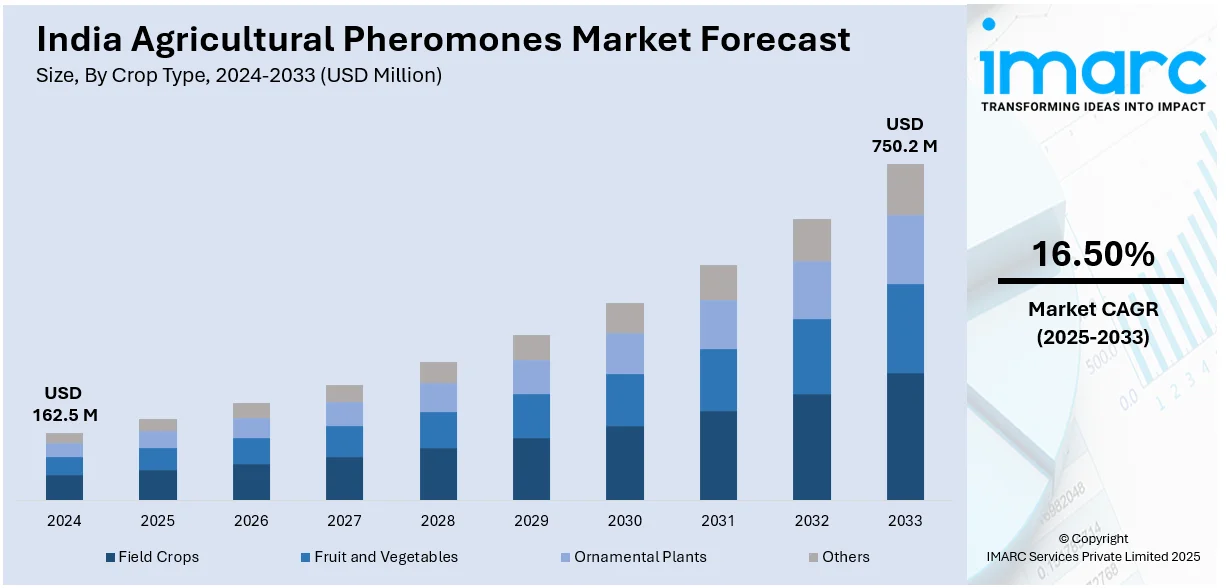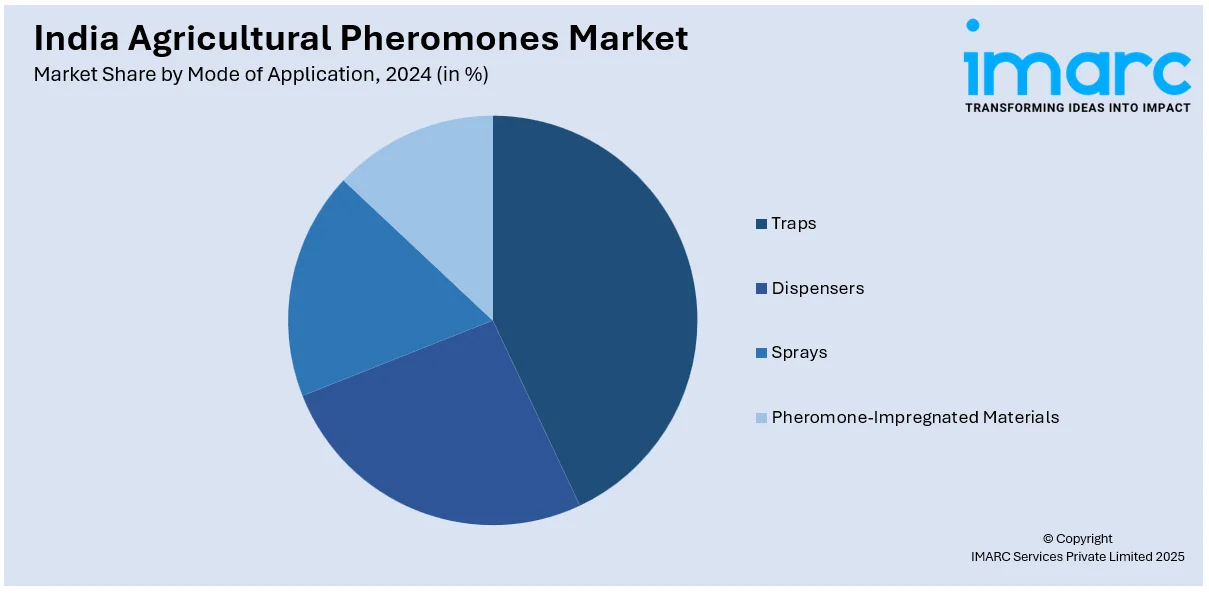
India Agricultural Pheromones Market Size, Share, Trends and Forecast by Crop Type, Function, Mode of Application, and Region, 2025-2033
India Agricultural Pheromones Market Overview:
The India agricultural pheromones market size reached USD 162.5 Million in 2024. Looking forward, IMARC Group expects the market to reach USD 750.2 Million by 2033, exhibiting a growth rate (CAGR) of 16.50% during 2025-2033. The Indian market for agricultural pheromones is witnessing consistent growth with the growing use of environmentally friendly pest control measures. Moreover, growing awareness among farmers regarding integrated pest management and government policies favoring sustainable agriculture are fueling demand. Also, advances in pheromone-based pest monitoring and control are propelling market growth.
|
Report Attribute
|
Key Statistics
|
|---|---|
|
Base Year
|
2024
|
|
Forecast Years
|
2025-2033
|
|
Historical Years
|
2019-2024
|
| Market Size in 2024 | USD 162.5 Million |
| Market Forecast in 2033 | USD 750.2 Million |
| Market Growth Rate 2025-2033 | 16.50% |
India Agricultural Pheromones Market Trends:
Growing Adoption of IPM Solutions
Integrated pest management (IPM) is increasingly emerging as an accepted method of farming in Indian agriculture, thus boosting demand for pheromone-based pest control. Farmers are moving towards eco-friendly alternatives to reduce chemical pesticide usage without compromising on crop protection. Demand for residue-free products, particularly for exports, is also propelling the use of biological methods of pest control. Government initiatives encouraging sustainable agriculture are fueling this trend, with subsidies and public education campaigns assisting farmers in switching to non-toxic products. Further, pheromone product development and dispensing technology innovations, including controlled-release dispensers, are making products more effective and affordable. Firms are diversifying their product lines to cover a wider variety of crops, making it more accessible to small and medium-scale farmers. Another factor driving demand for pheromones in IPM programs is the increasing threat of pest resistance to pesticides. With traditional pesticides losing efficacy, farmers are looking for long-term solutions that protect crops without killing beneficial insects. Also, regulatory limits on chemical pesticides are expediting the transition to eco-friendly alternatives, further driving market growth.

To get more information on this market, Request Sample
Expansion of Organic Farming Practices
The growth of organic farming in India is creating new opportunities for agricultural pheromones. Farmers are looking for safe and effective pest control methods that align with organic certification requirements. Pheromone-based solutions provide targeted pest management, reducing reliance on synthetic pesticides. Rising consumer demand for organic produce is prompting farmers to adopt natural pest control techniques. Certification bodies are increasingly recognizing pheromone-based solutions, boosting their credibility. Moreover, advancements in pheromone synthesis and slow-release formulations are making these solutions more practical for widespread use. Several companies are investing in research to develop pheromones for region-specific pests, catering to the diverse agricultural landscape in India. In addition to farmer adoption, retailers and food brands are placing greater emphasis on pesticide-free produce, further driving the use of pheromone-based pest control. The government’s push for organic farming through financial incentives and policy support is strengthening market growth. Moreover, collaborations between research institutions and private players are leading to innovative solutions with improved efficiency.
India Agricultural Pheromones Market Segmentation:
IMARC Group provides an analysis of the key trends in each segment of the market, along with forecasts at the region/country level for 2025-2033. Our report has categorized the market based on crop type, function, and mode of application.
Crop Type Insights:
- Field Crops
- Fruit and Vegetables
- Ornamental Plants
- Others
The report has provided a detailed breakup and analysis of the market based on the crop type. This includes field crops, fruit and vegetables, ornamental plants, and others.
Function Insights:
- Mass Trapping
- Mating Disruption
- Monitoring and Detection
A detailed breakup and analysis of the market based on the function have also been provided in the report. This includes mass trapping, mating disruption, and monitoring and detection.
Mode of Application Insights:

- Traps
- Dispensers
- Sprays
- Pheromone-Impregnated Materials
A detailed breakup and analysis of the market based on the mode of application have also been provided in the report. This includes traps, dispensers, sprays, and pheromone-impregnated materials.
Regional Insights:
- North India
- South India
- East India
- West India
The report has also provided a comprehensive analysis of all the major regional markets, which include North India, South India, East India, and West India.
Competitive Landscape:
The market research report has also provided a comprehensive analysis of the competitive landscape. Competitive analysis such as market structure, key player positioning, top winning strategies, competitive dashboard, and company evaluation quadrant has been covered in the report. Also, detailed profiles of all major companies have been provided.
India Agricultural Pheromones Market News:
- September 2024: Syngenta Biologicals and Provivi partnered to develop pheromone-based pest control solutions for India’s agriculture sector. Targeting Yellow Stem Borer in rice, this innovation enhances sustainable farming, reduces chemical pesticide use, and strengthens India’s agricultural pheromones market by promoting eco-friendly, species-specific pest management techniques.
- September 2024: JNCASR and ICAR–NBAIR developed a cost-effective pheromone dispenser with controlled release technology, partnering with KVSSL for large-scale production. This innovation lowers pest management costs for Indian farmers, extends dispenser efficiency, and strengthens the agricultural pheromones market by promoting sustainable pest control solutions nationwide.
India Agricultural Pheromones Market Report Coverage:
| Report Features | Details |
|---|---|
| Base Year of the Analysis | 2024 |
| Historical Period | 2019-2024 |
| Forecast Period | 2025-2033 |
| Units | Million USD |
| Scope of the Report | Exploration of Historical Trends and Market Outlook, Industry Catalysts and Challenges, Segment-Wise Historical and Future Market Assessment:
|
| Crop Types Covered | Field Crops, Fruit and Vegetables, Ornamental Plants, Others |
| Functions Covered | Mass Trapping, Mating Disruption, Monitoring and Detection |
| Mode of Applications Covered | Traps, Dispensers, Sprays, Pheromone-Impregnated Materials |
| Regions Covered | North India, South India, East India, West India |
| Customization Scope | 10% Free Customization |
| Post-Sale Analyst Support | 10-12 Weeks |
| Delivery Format | PDF and Excel through Email (We can also provide the editable version of the report in PPT/Word format on special request) |
Key Benefits for Stakeholders:
- IMARC’s industry report offers a comprehensive quantitative analysis of various market segments, historical and current market trends, market forecasts, and dynamics of the India agricultural pheromones market from 2019-2033.
- The research report provides the latest information on the market drivers, challenges, and opportunities in the India agricultural pheromones market.
- Porter's five forces analysis assist stakeholders in assessing the impact of new entrants, competitive rivalry, supplier power, buyer power, and the threat of substitution. It helps stakeholders to analyze the level of competition within the India agricultural pheromones industry and its attractiveness.
- Competitive landscape allows stakeholders to understand their competitive environment and provides an insight into the current positions of key players in the market.
Key Questions Answered in This Report
The agricultural pheromones market in India was valued at USD 162.5 Million in 2024.
The India agricultural pheromones market is projected to exhibit a CAGR of 16.50% during 2025-2033, reaching a value of USD 750.2 Million by 2033.
The India agricultural pheromones market is driven by increasing demand for eco-friendly pest control, rising awareness about integrated pest management, and growing concerns over chemical pesticide residues. Supportive government initiatives promoting sustainable farming practices are also encouraging the adoption of pheromone-based solutions across various crop segments.
Need more help?
- Speak to our experienced analysts for insights on the current market scenarios.
- Include additional segments and countries to customize the report as per your requirement.
- Gain an unparalleled competitive advantage in your domain by understanding how to utilize the report and positively impacting your operations and revenue.
- For further assistance, please connect with our analysts.
 Request Customization
Request Customization
 Speak to an Analyst
Speak to an Analyst
 Request Brochure
Request Brochure
 Inquire Before Buying
Inquire Before Buying




.webp)




.webp)












